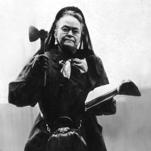Portrait of the Artist as a Perverse Man
Why I can no longer separate Woody Allen the director from Woody Allen the person
Photo by Christopher Polk/Getty Images
I first watched Annie Hall as a teenager, and by the closing credits I had became a Woody Allen fan. Since then, I have followed director’s career closely and seen nearly all of his films. Yet when his new, as-yet-untitled movie for Amazon Studios was announced—and more precisely, when it was announced that the movie would star Selena Gomez among other twenty-something baby-faced stars, I grimaced along with the rest of the internet.
I realized the casting bothered me. It was not because Selena Gomez is a terrible actress, rather, it made me uneasy to see young women such as Gomez and Elle Fanning working with the man accused of molesting his adopted daughter, Dylan Farrow, before marrying Soon Yi-Previn, another adopted daughter of his longtime partner and film collaborator Mia Farrow.
A Real-Life Recap
In 1993, when Allen and their Mia Farrow split after she found naked photos of Soon-Yi Allen had taken, Dylan went public about her allegations against her father.
Dylan penned a vivid, searing, and detached open letter in The New York Times that began with a heart-wrenching account of the abuse.
“What’s your favorite Woody Allen movie?” she writes. “Before you answer, you should know: when I was seven years old, Woody Allen took me by the hand and led me into a dim, closet-like attic on the second floor of our house. He told me to lay on my stomach and play with my brother’s electric train set. Then he sexually assaulted me. He talked to me while he did it, whispering that I was a good girl, that this was our secret, promising that we’d go to Paris and I’d be a star in his movies.”
The grotesque account does not end there—Dylan goes on to detail other inappropriate things her father did to her when she was young. When I first read her plea to think twice before loving his movies, I was sympathetic, but the issue was messy, complicated and contentious. I didn’t know who was telling the truth, so I continued watching nonetheless.
There were opposing perspectives, after all. In a page given Allen by The New York Times for a response, Allen quotes another member of the family, his son Moses Farrow, who was 14 at the time.
“Of course Woody did not molest my sister … She loved him and looked forward to seeing him when he would visit. She never hid from him until our mother succeeded in creating the atmosphere of fear and hate towards him.”
It is entirely possible that Farrow aimed to malign Allen during their messy break up, but there are some problems with the quote. First, Dylan was seven when the alleged assault occurred. It is completely within the realm of possibility that she did in fact love her abuser—as many victims of abuse do—only to realize what had happened to her as the years passed. (Dylan writes in the Times that she started asking her mother questions about the assault before she understood what had happened to her.)
Of course, it isn’t unreasonable that Allen’s teenage son would defend his father. But then again, Dylan’s other brother, Ronan Farrow, supports his sister’s claims. Ronan is Allen and Farrow’s biological son, though some speculate that he may actually be the son of Frank Sinatra through infidelity. (The truth is opaque.)
In response to his sister’s letter, Ronan wrote an op-ed in The Hollywood Reporter.
“I believe my sister,” he writes. “This was always true as a brother who trusted her, and even at five years old, was troubled by our father’s strange behavior around her: climbing into her bed in the middle of the night, forcing her to suck his thumb—behavior that had prompted him to enter therapy focused on his inappropriate conduct with children prior to the allegations.”
These details: thumb sucking and wearing only undergarments in her bed are consistent in both Dylan and Ronan’s writing on the subject. Furthermore, Ronan also believes his sister’s claim to be credible as an attorney and journalist, and cites reporter Marueen Orth’s work in Vanity Fair as an accurate catalog of well-documented circumstantial evidence against Allen including, among other things, that the court ruled their father should be kept away from his daughter for her safety.
Always a Father Figure
While Allen vehemently denies molesting the young girl he raised, he has spoken publicly about raising his current wife. Allen’s relationship with Soon-Yi is depicted in a documentary about him, simply titled Woody Allen: A Documentary. Though the film depicts their relationship as innocuous, there is no escaping the fact that Allen contributed to raising his wife.
Soon-Yi, a Korean-born orphan, was adopted before Farrow and Allen were together. Still, Allen was Soon-Yi’s father figure during their years as a couple. Allen openly admitted to having a paternal relationship with her when he was romantically involved with her mother.
“I’m 35 years older,” Allen said of his young wife in an interview with NPR, “and somehow, through no fault of mine or hers, the dynamic worked. I was paternal. She responded to someone paternal. I like her youth and energy. She deferred to me, and I was happy to give her an enormous amount of decision-making just as a gift and let her take charge of so many things. She flourished …”
When I first heard of the molestation accusations and strange marriage, I tried to be impartial and weigh the evidence as it came to me, but the circumstantial proof began to pile up. I’d like to say the allegations were enough to turn me off to Allen, but they weren’t—I continued to watch his movies.
Ultimately, it wasn’t the real-life reports that stopped me from appreciating the art; it was the art itself, and how it became impossible to not see the very things Allen was accused of played out—often by him—on the silver screen.
Art Imitates Life?
So, even after being familiar with all the accusations, I was willing to separate the artist from the art. Even as I accepted the likelihood that Allen was a pervert and pedophile, I could continue to enjoy his movies, right? Except when I returned to those films a second time around, I found it was no longer so simple. Those classic Allen films, with their now impossible-to-ignore inappropriate sexual relationships and dialogue, those by most measures deeply personal films—they now struck me as cinematic iterations of Allen’s real-life behavior.
Take Manhattan, the black-and-white classic I was enamored with when I saw it as a teenager. At one time, I considered it a masterpiece.
In Manhattan, Allen plays a television writer who is dating a young high school girl (Mariel Hemingway). The actors even shared Hemingway’s first kiss in real life and on screen.
Not only is this relationship wildly inappropriate—even on film—for his age, then 42, the character’s refusal to take any meaningful responsibility reflects Allen’s behavior in reality. Hemingway herself claims the filmmaker tried to seduce her when she was still a teenager.
The account is described in Hemingway’s memoir Out Came the Sun, where she writes that two years after Manhattan was made Allen attempted to lure her to Paris once she turned 18, the same way he promised his daughter Dylan they would go to the romantic European city when he allegedly sexually assaulted her. Allen came to Hemingway’s parent’s home in Idaho to fly with her to Paris but left the next day after Hemingway refused to go if she didn’t have her own room.
The time I first saw Manhattan, I thought the character was mature for her age, and though it was inappropriate it was only a movie, Learning that Allen actually had attempted to seduce the young woman? There goes any enjoyment in watching my favorite of his films.
The pervasive themes of incest and molestation make their way into Allen’s films more subtly, in dialogue found in his earlier films. In Hannah and Her Sisters, starring Mia Farrow, television writer Mickey, played by Allen, attempts to get a sketch about molestation on his show that is taken out by the producer. While asking “why all of a sudden is the sketch dirty?” the producer replies:
“Child molestation is a touchy subject with the affiliates.”
“Read the papers,” Allen’s character replies, “half the country’s doing it!”
“Yes, but you name names.”
This may seem innocuous, but again and again this recurring theme pops up. Take for instance, a scene from Stardust Memories where Allen’s character Sandy jokes about incest with his lover Dorrie.
“What about you?” Sandy asks. “Did you have a little crush on him? You can admit this to me if you like.”
“Sure, we had a little flirting.”
“A little small flirt? Mother away getting shock treatment, and the only beautiful daughter at home. Long lingering breakfasts with Dad.”
Or how about this scene from later in the film about Dorrie’s kid cousin:
“I’m not attracted to her,” Sandy says defensively. “What are you talking about?”
“Staring at her all through dinner. Giving each other looks.”
“Stop it. She’s fourteen. She’s not even fourteen. She’s thirteen and a half.”
“I don’t care,” Dorrie says, “I used to play those games with my father, so I know. I’ve been through all that.”
When I first saw Stardust Memories, I thought these scenes were simply jokes about molestation and incest that, at the time, I thought were pretty funny. The realization that the man who was making these jokes had been accused of similar behavior was sickening.
The tendency of Allen’s films to possess uncomfortable levels of, let’s call it biographical resonance, is not restricted to his older films. There is 2009’s Whatever Works, which stars Larry David as a quintessential Allen character. The plot focuses on an aging New Yorker named Boris, played by David, who finds a young southern belle at his doorstep. In traditional Allen fashion, the woman is simple-minded and develops a crush on the much older man. It is a wholly inappropriate relationship. She is much too young for Boris yet lusts after him. Boris reluctantly develops mutual feelings for the young woman, as if Allen’s characters had a moral compass concerning young girls. Boris eventually tries to kill himself after the young woman, played by Evan Rachel Wood, falls for another man.
The main character in Whatever Works is as much David as it is Allen, but for this viewer at least, it’s no longer possible to ignore the perv behind the curtain.
Ryan Beitler is a journalist, fiction writer, poet, musician, and travel blogger. He has written for Paste, Addiction Now, OC Weekly, and his blog Our Little Blue Rock. He can be reached at [email protected].







































